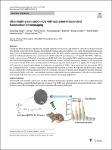Search
Author
- Ahmad, Karim (1)
- Alireza, Jafarinia (1)
- Amandeep, Singh (1)
- Astha, Sharma (1)
- next >
Subject
Date issued
Has File(s)
- true (3)
Search Results
Current and future diagnostics urgently need imaging agents that are non-toxic and superior to clinically used small molecule dyes. Herein, we have developed luminescent green light-emitting carbon dots (GCDs) via a single-step hydrothermal reaction using a low-cost chemical precursor, p-toluenesulfonic acid. The GCDs exhibit excitation-independent fluorescence (FL) emission with the photoluminescence quantum yield of 70% and no FL quenching up to 1.25 mg/mL. The GCDs exhibit negligible cytotoxicity up to 250 µg/mL concentration in RAW 264.7 cells. Interestingly, GCDs exhibit an excitation-independent and concentration-dependent fluorescence emission behaviour. In vitro, the peak emission was obtained at 520 nm using the excitation at 430 nm. |
Federated learning (FL) is a promising framework for distributed machine learning that trains models without sharing local data while protecting privacy. FL exploits the concept of collaborative learning and builds privacy-preserving models. Nevertheless, the integral features of FL are fraught with problems, such as the disclosure of private information, the unreliability of uploading model parameters to the server, the communication cost, etc. Blockchain, as a decentralized technology, is able to improve the performance of FL without requiring a centralized server and also solves the above problems. In this paper, a systematic literature review on the integration of Blockchain in federated learning was considered with the analysis of the existing FL problems that can be compensate... |
Type B aortic dissection (TBAD) carries a high risk of complications, particularly with a partially thrombosed or patent false lumen (FL). Therefore, uncovering the risk factors leading to FL thrombosis is crucial to identify high-risk patients. Although studies have shown that morphological parameters of the dissected aorta are related to FL thrombosis, often conflicting results have been reported. We show that recent models of thrombus evolution in combination with sensitivity analysis methods can provide valuable insights into how combinations of morphological parameters affect the prospect of FL thrombosis. Based on clinical data, an idealized geometry of a TBAD is generated and parameterized. After implementing the thrombus model in computational fluid dynamics simulations, a g... |



